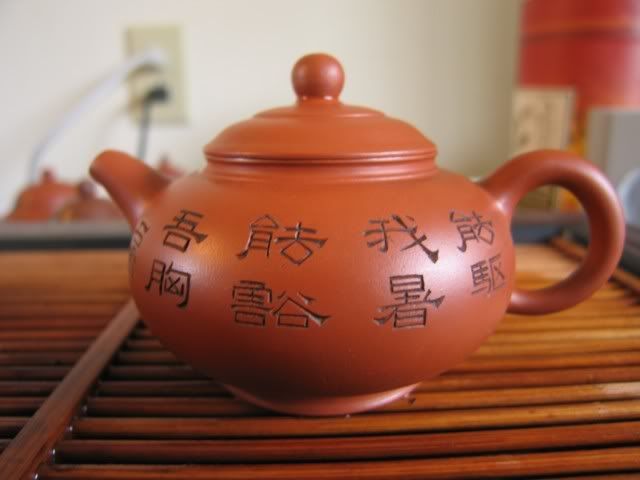I brewed up the tieguanyin that Toki sent me a while back again. It’s a nice tea, a bit roasty, but soft and mellow and not really bitter at all. These days, I’m using mostly my black teapot, but today I pulled out my old (and small) tieguanyin pot. It’s a smaller pot that really only pours out one cup, and it works fairly well for teas like this

It’s a joy to see pots season over time and gaining a sheen that it didn’t use to have.
But something came to mind today while I was making this tea — how fast do you drink your tea?
The reason I ask is because there’s always this constant concern with brewing parameters, specifically how long each infusion lasts. I think readers of my blog probably know that I generally don’t pay a lot of attention to exactly how long I use for each infusion, and instead I just brew as they come. Yet….. how long you take to drink your tea matters. Why? Because while you’re drinking your cup, the tea is still brewing, sort of. The leaves are wet, and they are stewing in that little bit of water that you have left in the pot/gaiwan. Today, for example, in between a few infusions I took a little longer because I was a little occupied with other things… and the infusions after those are inevitably a little sour with a little more tartness.
So what does this mean? If you’re really serious about keeping time, then you ought to keep time you spend drinking your cups (i.e. time between infusions) as well. Otherwise… my parameters of 5, 5, 5, 10, 10, 15 might work for me because I am only brewing one small cup and drinking them, but not for you because you take longer to drink your two cups… something like that.
Which is again why I think it’s better if you just experiment with various times and figure out what works for your style and what doesn’t

4 responses so far ↓
m_marduk // February 6, 2008 at 2:22 am |
Well, there is always the 24 – 48 – 72hr brew in a mug approach. 🙂 The augment for doing this raised an eyebrow, “I wanna taste my tea…”
Anonymous // February 6, 2008 at 5:27 am |
Very interesting!
I wonder if all teas are equal in relationship to that. I have a feeling puerh is less sensitive to time lags between successive brews. What do you think?
lewperin // February 6, 2008 at 2:28 pm |
You’ve rediscovered something important in noticing that the steaming leaves in a covered brewing vessel actually continue to “steep” between steeps. I say rediscovered because DogMa covered this in a very insightful post years ago on RFDT.
There’s another way in which the time between steeps influences the resulting soup. If you let a long time elapse, you have a cool mass consisting of the brewing vessel plus the hydrated leaves when you pour on the hot water next time. This means that the actual brewing temperature is much lower than if you had done another steep immediately after pouring off the earlier steep.
MarshalN // February 6, 2008 at 4:00 pm |
Marduk: 24 hours brews do work…. just ask anybody who’s brewed 50 years old teas 🙂
Nad: I think puerh, if anything, is more sensitive, because bitterness really shows up if you wait too long, especially for younger puerhs.
Lew: Ah, RFDT…. that’s too much work for me to track down, but yes, you’re absolutely right that temperature also plays a role, although what I had in mind today was sourness/bitterness, which is more of a duration problem than a temperature problem.